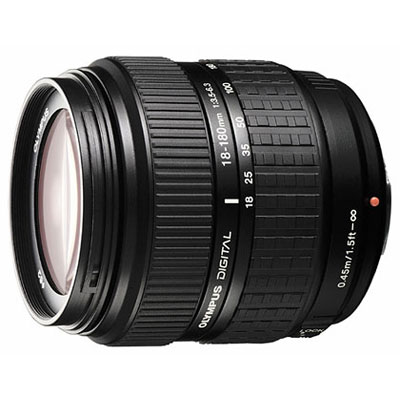Olympus Zuiko Digital ED 18-180mm f/3.5-6.3

Panasonic also offer a 10x zoom for Four Thirds cameras. Their 14-140mm costs around £730 but starts at a wider angle than the Olympus lens and has in-lens optical stabilisation.
Olympus Zuiko Digital ED 18-180mm 1:3.5-6.3: Handling and features
Weighing only 435g and being 84.5mm long, this 10x zoom from Olympus is no bigger than the standard lenses typically bundled with most SLRs as a kit. The build quality is quite good, with the barrel being constructed from high quality injection moulded plastics.
An internal focus design is used so the lens doesn't extend and the front filter thread doesn't rotate during focusing. This will make use of filters such as ND grads and polarisers much easier than on lenses where the front rotates. Autofocus seems fairly quick and accurate in good light, but I do find the lens will hunt a little at the long end of the zoom, especially in low-light conditions.
Manual focus is performed via a fly-by-wire system that uses the focusing motor to adjust the focus position when the manual focus ring is turned. I find this system can be an acquired taste, sometimes making it more difficult to make fine adjustments than when the focus is adjusted directly.
Zooming to 180mm pretty much doubles the length of the lens and the zoom mechanism is nice and smooth throughout the range. There is just enough resistance in the mechanism to avoid lens creep when the camera is pointed downwards, which prevent issues when the lens is used on a tripod.
I find the lens balances well on the Olympus E-30 used for testing, although the light weight and small size of the lens can make it difficult to hold steady at the maximum zoom.
Olympus Zuiko Digital ED 18-180mm 1:3.5-6.3: Performance
For this review, the lens was tested on a 12Mp Olympus E-30 using Imatest.
Typical of many super-zoom lenses, this lens performs at its best at the shortest end of the zoom. At 18mm and F/3.5 the lens performs well enough, but stop the lens down just a third of a stop to F/4 and the resolution across the frame is at very good levels. Peak performance is at F/8, where the lens is very good from corner to corner.
At 50mm, the resolution at maximum aperture drops a little, but is still acceptable. Just as with at 18mm, stopping down to the next full stop, which is F/5.6 in this case, leads to a noticeable increase in sharpness. Peak performance is still at F/8, where the lens still produces very good resolution across the frame.
Zooming the lens to 180mm reduces the overall performance of the lens, but the results are still acceptable at each aperture setting. Peak performance has now moved to F/11, where the centre resolution approaches good levels.
Resolution at 18mm

Resolution at 50mm

Resolution at 180mm

For a super-zoom lens, chromatic aberrations are quite well controlled. At 18mm, they are actually stronger in the centre of the image, than towards the edges, only just exceeding 0.75 pixel-widths at F/3.5. This level shouldn't pose too many issues, except maybe in very high contrast situations. At 50mm, colur aberrations drop t very low levels indeed, but rise again as the lens is zoomed to 180mm. They are still within acceptable levels at 180mm, being just short of 0.7 pixel widths at F/16.
Chromatic aberrations at 18mm

Chromatic Aberrations at 50mm

Chromatic Aberrations at 180mm

Falloff is reasonably well controlled. At 18mm and F/3.5 the far corners of the image are 1.02 stops darker than the centre of the image. Stopping down to F/5.6 results in even illumination here. Zooming to 180mm reduces the effect of vignetting at maximum aperture. Here the corners of the image are only 0.52 stops darker than the image centre.
Distortion is often quite pronounced at the extremes of the zoom range with super-zooms and this is the case with this lens too. At 18mm, Imatest recorded 3.26% barrel distortion, which may play havoc in images where straight lines are critical, such as with architecture. At 180mm, Imatest recorded 1.05% pincushion distortion, which will be less noticeable in normal use. Luckily the shape of the distortion is uniform, so it should be quite easy to correct in image editing software afterwards.
 |  |
Unfortunately, this lens is quite susceptible to flare with strong point sources of light in the frame. Depending on the strength of the light the flare can range from a quite pleasing pattern across the frame to a rather ugly looking loss of contrast with added white blobs for good measure. As this happens when the light source is in the frame, using the supplied lens hood can't help you here. When the light source is outside of the frame the lens is just as susceptible to flare and loss of contrast. Using the supplied hood can help here, but as it can only shade the area covered by the shortest focal length, it has limited effect.
Olympus Zuiko Digital ED 18-180mm 1:3.5-6.3: Verdict
 Those who are in the market for a compact, all-purpose super-zoom can't go far wrong with this lens. Although it does have some weaknesses, it is capable of producing images with very good resolution at shorter focal lengths, and the quality doesn't drop off to severely at the long end either. It is quite reasonably priced too.
Those who are in the market for a compact, all-purpose super-zoom can't go far wrong with this lens. Although it does have some weaknesses, it is capable of producing images with very good resolution at shorter focal lengths, and the quality doesn't drop off to severely at the long end either. It is quite reasonably priced too.Olympus Zuiko Digital ED 18-180mm 1:3.5-6.3: Pros
 Good resolution at the shorter end
Good resolution at the shorter end Light weight
Light weight Compact
CompactOlympus Zuiko Digital ED 18-180mm 1:3.5-6.3: Cons
 Flare control
Flare control Barrel distortion at 18mm
Barrel distortion at 18mm| FEATURES |  |
| HANDLING |  |
| PERFORMANCE |  |
| VALUE FOR MONEY |  |
| OVERALL |  |
Olympus Zuiko Digital ED 18-180mm 1:3.5-6.3: Lens specification
| Price: | £420 |
| Contact: | http://www.olympus.co.uk |
| Filter size: | 62mm |
| Format: | Four Thirds |
| Construction: | 15 elements in 13 groups |
| Angle-of-view: | 62 to 6.9 degrees |
| 35mm equivalent focal length (on Four Thirds body): | 36-360mm |
| Internal focusing: | Yes |
| Image stabilisation: | No |
| Minimum focus: | 45cm |
| Maximum aperture: | f/3.5-5.6 |
| Minimum aperture: | f/22 |
| Weight: | 435g |
| Size (lxw): | 84.5mm x 78mm |
| In the box: | Lens hood |
The Olympus Zuiko Digital ED 18-180mm f/3.5-6.3 costs £421.99 and is available from Warehouse Express here:
Olympus Zuiko Digital ED 18-180mm f/3.5-6.3
Add your message
Login required
Please login here or if you've not registered, you can register here. Registering is safe, quick and free.
Please login here or if you've not registered, you can register here. Registering is safe, quick and free.
photodo Stats
1102 lenses
428 MTF tests
74 in-depth photodo reviews
100+ users join each day
Help the lens community by reviewing or rating a lens today via our lens search
428 MTF tests
74 in-depth photodo reviews
100+ users join each day
Help the lens community by reviewing or rating a lens today via our lens search
Latest Lens Reviews
- Chinon 28mm f/2.8 Vintage Lens Review
- Canon EF 70-200mm f/4L IS II USM Lens Review
- Samyang AF 85mm f/1.4 EF Review
- Sigma 70mm f/2.8 DG Macro Art Review
- Samyang AF 24mm f/2.8 FE Review
- Meike 50mm f/1.7 Review
- Tamron 70-210mm f/4 Di VC USD Review
- Lensbaby Burnside 35mm f/2.8 Review
- Asahi Super Takumar 50mm f/1.4 Review
- Asahi Super-Multi-Coated Takumar 135mm f/3.5 Review
